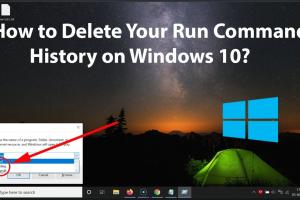Mastering Windows: A Comprehensive Guide to Deleting Run History

-
Quick Links:
- Introduction
- What is Run History?
- Why Delete Run History?
- How to Delete Run History
- Additional Privacy Tips
- Case Studies
- Expert Insights
- Conclusion
- FAQs
Introduction
In an age where privacy concerns are paramount, understanding how to manage your digital footprint is essential. One of the often-overlooked aspects of computer privacy is the Run history in Windows. This article provides an in-depth guide on how to delete Run history in Windows, tailored for users of all skill levels.What is Run History?
Run history refers to the log of commands you have executed using the Run dialog in Windows. This includes applications, files, and system commands you’ve opened through the Run interface. While this feature can be convenient, it also poses a risk to your privacy, especially in shared or public environments.Why Delete Run History?
Deleting Run history can help protect your privacy by: - **Preventing unauthorized access:** If someone else uses your computer, they won't be able to see what applications or files you've accessed recently. - **Improving system performance:** A clean Run history can sometimes lead to faster system performance. - **Reducing clutter:** Keeping your Run history tidy makes it easier to find commands you frequently use.How to Delete Run History
There are several methods to delete Run history in Windows. This section covers three effective techniques.Using Command Prompt
The Command Prompt is a powerful tool that can help you quickly delete your Run history. Follow these steps: 1. Press `Windows + R` to open the Run dialog. 2. Type `cmd` and press `Enter` to open the Command Prompt. 3. In the Command Prompt, type the following command and press `Enter`: ``` reg delete "HKCU\Software\Microsoft\Windows\CurrentVersion\Explorer\RunMRU" /f ``` 4. Close the Command Prompt. This command removes all items in the Run history.Using Registry Editor
If you prefer using the Registry Editor, follow these steps: 1. Press `Windows + R` to open the Run dialog. 2. Type `regedit` and press `Enter` to open the Registry Editor. 3. Navigate to the following path: ``` HKEY_CURRENT_USER\Software\Microsoft\Windows\CurrentVersion\Explorer\RunMRU ``` 4. Select all the entries in the right pane and delete them by right-clicking and choosing "Delete." 5. Close the Registry Editor.Using Privacy Settings
Windows has built-in privacy settings that allow you to manage your Run history: 1. Open the **Settings** app by pressing `Windows + I`. 2. Click on **Privacy**. 3. Under the **Activity history** section, uncheck the box that says, “Let Windows collect my activities from this PC.” 4. Scroll down to **Clear** and click the button to remove your activity history.Additional Privacy Tips
- Regularly clear your browser history and cache. - Use incognito or private browsing modes. - Utilize disk cleanup tools to maintain your system. - Consider using third-party privacy-focused applications.Case Studies
Case Study 1: A small business owner noticed that their employees were accessing sensitive files through the Run dialog. After implementing a routine to delete Run history, they reported an increase in overall system security. Case Study 2: A freelance graphic designer shared their computer with family members. By regularly deleting their Run history, they maintained a higher level of privacy regarding their client work.Expert Insights
According to cybersecurity experts, managing your digital footprint is vital in today's tech-centric world. Regularly deleting Run history is a simple yet effective step towards enhancing your privacy.Conclusion
Deleting Run history in Windows is a crucial step towards maintaining your digital privacy. By following the methods outlined in this article, you can ensure that your personal information remains secure.FAQs
1. What is the Run dialog in Windows?
The Run dialog is a feature in Windows that allows users to run programs or open files by typing commands directly.
2. Will deleting Run history affect my computer's performance?
While deleting Run history may not have a significant impact on performance, it can help declutter your system and improve loading times slightly.
3. Can I recover deleted Run history?
Once deleted, Run history cannot be recovered. It is advisable to be cautious when deleting sensitive information.
4. Is it safe to use Command Prompt to delete Run history?
Yes, using Command Prompt is safe as long as you follow the instructions correctly. Ensure you enter the command accurately.
5. Can I delete Run history for specific programs only?
No, deleting Run history clears all entries. You cannot selectively delete individual items.
6. Do I need administrator rights to delete Run history?
No, standard user rights are sufficient to delete Run history in Windows.
7. How often should I clear my Run history?
It's a good practice to clear your Run history regularly, especially if you share your computer with others.
8. What happens if I accidentally delete other registry entries?
Accidentally deleting other entries can cause system issues. Always back up the registry before making changes.
9. Are there third-party tools for managing my Run history?
Yes, several third-party applications can help manage and clear your Run history among other privacy settings.
10. Is Run history the same as browsing history?
No, Run history logs commands executed in the Run dialog, while browsing history pertains to web activity in browsers.
Random Reads
- How to remove vented hood fan
- How to remove venetian blinds
- How to install or replace door hinges
- How to install opitfine mod
- Connect two bluetooth speakers
- How to find and delete temporary files in windows 7
- How to attach large files folders outlook
- How to attach table legs
- How to reattach a keyboard key
- How to recall email in gmail